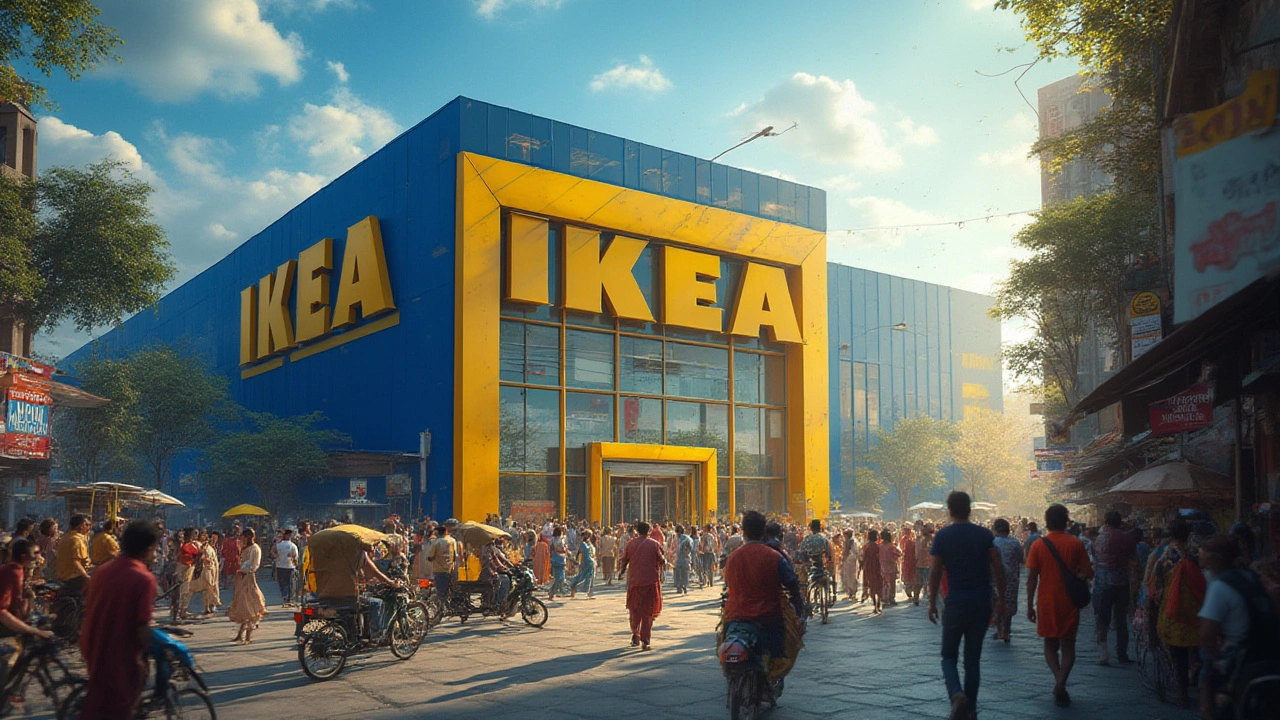No one knew quite what to expect when IKEA finally opened its doors in Hyderabad in 2018. There were viral videos of shoppers lining up at dawn, heated debates on social media about biryani in the store canteen, and an actual traffic jam just to get into the parking lot. Oddly enough, for a company famed for minimalist Scandinavian style, India greeted IKEA with true maximalist passion. So what pulled the world’s largest furniture retailer out of its European comfort zone and planted its blue-and-yellow flag in India? The answer runs deeper than the promise of a billion wallets.
The Untapped Giant: India’s Changing Consumer Landscape
IKEA’s interest in India didn’t just simmer overnight. For decades, the company watched as millions of young Indians flocked to cities, rode the so-called 'demographic dividend,' and gained new spending power. Imagine a population where more than 65% are under the age of 35—that’s about 650 million people, almost double the entire US population, all stepping into adulthood, forming families, and craving better homes. IKEA’s team studied this in detail, mapping city after city for growth. In fact, India’s middle class is projected to hit over 500 million by 2025, creating a total retail market worth more than $1 trillion. The numbers are wild—and no global brand worth its salt could ignore them.
But IKEA didn’t just spot big numbers; it understood subtle shifts. Urban apartments shrunk in size. Nuclear families became the norm. Renting took off among millennials. The result? A tidal wave of new customers who needed furniture that was affordable, modular, and easy to assemble or move. Contrast this with how Indian shopping for furniture often felt in the past: long waits at the local carpenter, bargaining over prices, or buying one solid wood bed that doubled as a family heirloom. Not exactly millennial-friendly. So the promise of snagging a TV unit for under ₹2,000 or a sofa bed for less than ₹10,000 made IKEA a disruptive force in a traditional market.
The company’s famous catalog, which is practically a global lifestyle bible, zeroed in on these needs. They even commissioned local studies: sleep habits, family routines, kitchen usage, color preferences—you name it. One finding stood out: Indian families love spending time together in the kitchen. So IKEA launched modular kitchens with higher durability and splash-proof cabinets, custom designed for turmeric, red chilli, and hot oil.
‘Make in India’: Opportunities in Local Manufacturing
Beyond selling stuff, IKEA saw India as a goldmine for sourcing and manufacturing. The 'Make in India' campaign set off in 2014, turning the country into a global hub for affordable production. Labor costs, raw materials, and engineering skills here offered IKEA a rare trifecta: quality, scale, and value. The company already had experience: India has long supplied textiles, carpets, and small items to IKEA’s global stores. But now, IKEA ramped it up.
Today, over 30% of the value of IKEA’s India products comes from Indian suppliers. That’s not just low-cost garnish; it’s a long-term strategy. The company tied up with hundreds of local businesses—from small family-run factories weaving baskets to mega manufacturers producing flat-packed furniture. Over the years, IKEA’s supplier list in India grew to over 60,000 jobs directly and many more indirectly. The intent? To eventually bring 50% of production in India, for India.
Working with India’s micro, small, and medium enterprises (MSMEs) was not just smart—it was necessary. Let’s face it: shipping big, bulky wardrobes from Europe to Indian cities would never work, given the cost and the wild swings in cargo timelines. Manufacturing right here unlocked two wins at once: competitive prices for customers, and lean, local supply chains immune to global shipping drama.
The government, too, rolled out the red carpet. Single-brand retail was finally opened to global giants like IKEA, subject to a 30% local sourcing rule. A few years back, such a policy was pegged as a major roadblock. But when policy softened, IKEA jumped in, becoming a poster child for foreign investment.

Navigating Cultural Roadblocks: Customizing for India
For IKEA, landing in India was never going to be as simple as plugging in their global bestsellers and watching cash registers ring. There were real, gritty challenges that no 'globalization' PowerPoint could brush aside. Indian homes are colorful, full of personality, and often run on unique habits. For instance, most kitchens have no dishwashers—so IKEA’s European plates, which are dishwasher-safe, needed a rethink. Beds needed to fit wider Indian mattresses. Sofa fabrics had to deal with dust and humidity. Even the classic IKEA dining sets looked tiny in homes where eating dinner together often meant squeezing around a mat on the floor.
And then came the food. It sounds small, but IKEA’s canteen is legendary in every city. The iconic Swedish meatballs? Not a chance in India. Instead, you get biryani, samosas, dal makhani, and masala tea. In 2023, their stores served over 4 million meals a year in India. Go figure. IKEA’s menu tweaks made headlines, but the company quietly made hundreds of product tweaks too: more low-height stools, storage solutions that doubled up as benches, and colors that pop against Indian marble and wood floors.
On pricing, IKEA had to conduct real soul-searching. Their core promise globally is “democratic design”—the idea that good design shouldn’t need a fat wallet. But high import duties and taxes made direct imports pricey. So, the company squeezed costs by flattening supply chains, designing knock-down models, ramping up local production, and reducing packaging waste. The result? Over 1,000 IKEA products in India are priced under ₹200—a direct challenge to local unbranded furniture sellers.
IKEA also trained Indian staff in Swedish customer service standards. When families arrived, they weren’t just shoppers—they were guests to be welcomed, guided, and given a taste of Nordic hospitality…plus a piping hot dosa.
The Long Game: India’s Growing Urban Future
So, did India deliver the gold rush IKEA expected? Well, the Hyderabad store clocked more than 3 million visitors in its first year alone. The Mumbai and Bengaluru outlets pulled similar numbers, often becoming family weekend destinations rather than just stores. E-commerce exploded as well, especially during Covid. By mid-2025, IKEA boasted an online reach into more than 200 cities, shipping everything from compact study tables for student hostels to full kitchen sets for newlyweds. Compare this to the US or China—markets IKEA entered long ago—and you’ll see India is actually blazing its own, unusual trail.
Check out the table below for a quick snapshot of IKEA’s expansion in India:
| Year | City | Store Visitors (First Year) | Key Product Tweaks |
|---|---|---|---|
| 2018 | Hyderabad | 3 Million | Larger mattresses, spicy menu |
| 2020 | Mumbai | 2.7 Million | Space-saving furniture |
| 2022 | Bengaluru | 2.5 Million | Dustproof fabrics, expanded kitchen range |
| 2025 | Online nationwide | Digital reach: 200+ cities | Affordable flat-pack sets |
The big lesson? IKEA didn’t conquer India by just being cheap. Instead, it listened, adapted, and played the long game. The company invested $1.5 billion upfront—a clear signal this wasn’t a passing fad. And with plans for 30 stores and many more digital hubs by 2030, IKEA is betting heavily on the Indian dream of better homes, even if it means rolling out furniture in 25 languages and countless local assembly crews.
Tips for global brands hoping to crack India? Don’t just copy-paste what worked elsewhere. Watch, learn, and listen to what locals want. Test products for humidity, price sensitivity, and family chaos. Take notes from IKEA: where others saw chaos, they saw a future full of crazy ambition and opportunity. And remember, the next billion shoppers don’t just want a sofa—they want their own story in every cushion and coffee table.
So the next time you walk past an IKEA store in India—rammed with crowds, food counters offering idli, and showrooms styled for a 2BHK—you’ll know: what attracted IKEA to India wasn’t just the numbers. It was the promise of making every home, however small or chaotic, a little bit more Swedish…and a whole lot more Indian.
